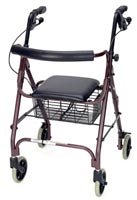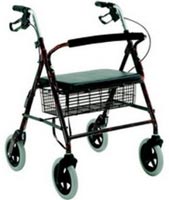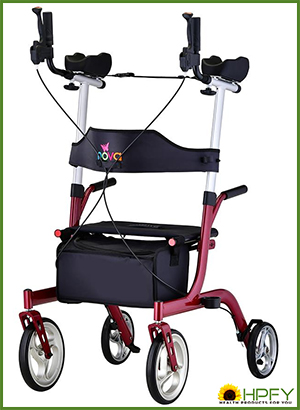Walking Aids - Walkers
Walkers are the last option for people who don't require or want to use a wheelchair and can't use canes or crutches safely. Basically the walker is a frame which the user takes with them and uses for support when their strength, stamina and/or balance while walking has been impaired by some condition or injury. A basic walker is just a metal frame which is in a "U" shape where the two arms of the "U" are at the sides of the user and the base of the "U" is across the front of the user. The handles for the user to grip are on the arms of the "U". The using of a conventional walker involves simply stepping into the walker, moving the walker forward, stepping into the walker, moving it forward etc. Disadvantages of this procedure are maintaining balance while moving the walker, some users may not have the strength to lift the walker, changing direction while walking requires the user to turn the walker while lifting and moving it forward. |

|
|
Wheels can be added to a conventional walker to ease the movement of the walker but this modification isn't as functional as using a walker which is designed to have wheels. Some manufacturers have designed conventional walkers which fold which s helpful for storage and transportation but is not advantageous to the user. Wheeled walkers are the norm today and come in two basic configurations. The first is considered an indoor walker which works best indoors or on hard flat surfaces. The second is considered an outdoor walker which will work fine indoors and works okay over rougher terrains found outdoors. |
|
Indoor wheeled walkers normally normally feature four wheels (the front two swivelling), a seat which doubles as a tray for carrying drinks and meals etc., a basket to carry purses and shopping etc. and padded bar or strap which serves as a bit of a backrest while sitting. This class of walker will also fold for storage and transportation. Having wheels on a walker eliminates the need to lift the walker when moving and better facilitate a more normal walking gait than the stop and go gait of a conventional walker. Having a seat is a great feature for those who suffer from a lack of stamina when walking because they always have a place to sit and rest when tired. Because using a walker requires the use of both hands it's very difficult to carry things. Having a seat which doubles as a tray will solve the problem of carrying things while using the walker. A padded bar or strap that can be used as a backrest is also a good feature for people who sit on the walker's seat. It gives the user some back support when sitting plus it will prevent the user from sitting too far back onto the walker and causing it to be unstable or tip over. The pictured model of indoor wheeled walker has the basket mounted under the seat. Some models of indoor walker feature the walker basket mounted out in front of the frame. When seated on a walker with the basket out in front, the user is facing away from the basket making it unsafe to keep anything of value in the basket. |

|
| Outdoor walkers offer the same features as the indoor walkers with the added feature of brakes similar to the brakes one would find on a bicycle. Outdoor walkers are constructed of heavier metal and have larger wheels than indoor walkers which is why they are better suited to outdoor use than the indoor walkers. Many people feel more secure because of the heavier weight of the outdoor walker and the larger wheels even when used indoors. The larger wheels of an outdoor walker will roll over little obstacles such as sidewalk cracks and softer surfaces such as gravel driveways and lawns better than indoor walkers. The brakes of an outdoor walker can be used to slow the walker down while walking on inclines such as ramps and hills so the walker can't get away from the user. The brakes can also be locked on for safety while sitting and to prevent the walker from rolling away if left parked on an incline. No one should ever sit on a walker without having the brakes locked on. I've seen people in malls sitting on their walkers and propelling themselves backward by pushing with their feet. This is a very dangerous use of their walker as they aren't designed to be moved while the user is sitting on the seat and is prone to tipping over forward if an obstacle is hit while moving. |

|


 Online Vendors
Online Vendors  US Online Vendors
US Online Vendors 
